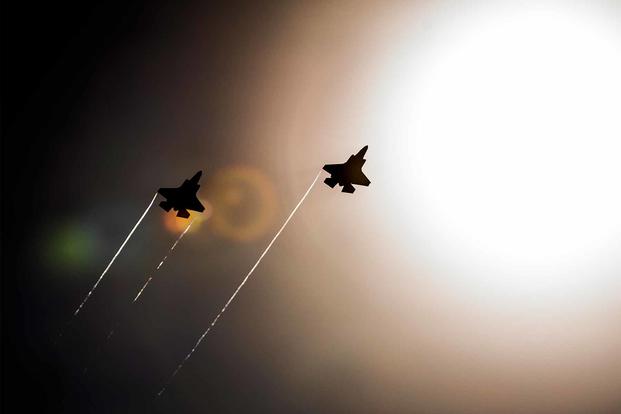The U.S. Air Force has determined that an F-35 Joint Strike Fighter crash at Eglin Air Force Base, Florida, in May was largely due to excessive speed while landing, but there were multiple contributing factors, according to a new investigation report.
An Accident Investigation Board report released Sept. 30 concluded that the pilot, an instructor who sustained minor injuries after ejecting, set the airspeed at 202 knots for landing -- approximately 50 knots too fast, according to the report. The pilot was not identified for privacy reasons.
The aircraft bounced, rolled, "caught fire and was completely destroyed," the report states.
Read Next: Military Leaders in Quarantine After Coast Guard’s No. 2 Admiral Tests Positive for COVID-19
Given its speed, the aircraft came in too shallow on its approach angle, causing the F-35's main landing gear and nose landing gear to impact the ground at the same time instead of gradually easing the nose down on the flight line, according to the board president, Col. Bryan T. Callahan.
"This resulted in a rapid and excessive nose-high bounce," he concluded.
The pilot attempted to recover twice. On the second attempt, he tried to raise the nose and initiate a go-around. He was unable to do so, in part because the stick inputs to move the aircraft were "out of sync" with the flight controls, Callahan said in the report.
"The conflicting inputs caused the flight control system to input a large bias value, which kept pushing the nose down," the report states.
The system was overwhelmed by the numerous attempts to get the aircraft level and recover, instead becoming "saturated and unresponsive," it adds.
"Three seconds was not enough time to null out the flight control system's efforts to keep the nose down," according to the report. The pilot, it continues, felt "ignored" by the flight control system and "helpless" after his two failed attempts to regain control, which "ultimately drove [his] decision to eject."
The May 19 crash followed the pilot's participation in a simulated red-and-blue air mission, or an adversary aircraft going up against the stealth aircraft.
The F-35A Lightning II, assigned to the 58th Fighter Squadron of the 33rd Fighter Wing, crashed around 9:30 p.m. local time. The instructor suffered a spinal compression injury, as well as shards of debris in both his eye and arm.
The aircraft, tail number 12-005053, was valued at approximately $176 million. There was no damage to surrounding property, officials said at the time.
Callahan pinpointed other factors that led to the mishap.
For example, during the flight, the instructor noticed an alignment discrepancy within his helmet-mounted display, which projects information in front of the pilot.
The instructor was distracted "during a critical phase of flight," becoming too focused on the heads-up display to properly cross-check his angle of attack -- the approach angle relative to the ground -- or the appropriate airspeed, according to Callahan.
Furthermore, the pilot felt fatigued because of a pressure change within the aircraft's oxygen delivery system.
"It is known amongst the F-35 flying community that the oxygen delivery system is very different than legacy oxygen delivery systems, such as the one used in the [F-15E Strike Eagle]," the report states. The instructor pilot previously flew the Strike Eagle.
The pilot was also fatigued from getting poor sleep prior to the mission, it adds.
The report did not highlight corrective actions, but Callahan noted that there is no warning system to alert the pilot about mistaken inputs such as the wrong airspeed.
There are "no audible warnings for a dangerous configuration," Callahan said. "The [mishap pilot] continued the approach unaware of the aircraft's incorrect configuration as there was no need for throttle interactions, no airspeed, no [angle of attack] crosscheck, and no cueing system to alert [him that] he's in the wrong throttle mode for touchdown."
The 33rd Fighter Wing is the leading training wing for F-35 student pilots at the base. Although the F-35 is the Pentagon's newest and most advanced aircraft, the oldest Joint Strike Fighters in the fleet reside at Eglin. The planes were part of Lockheed Martin's earliest low-rate initial production batches.
The crash marked the second accident at Eglin in roughly a week's time that month.
Days earlier, an F-22 Raptor crashed during a routine training flight near Eglin. That pilot was also able to eject safely; the crash occurred roughly 12 miles northeast of the base on the test and training range. No injuries were reported.
An investigation into that mishap is still underway.
-- Oriana Pawlyk can be reached at oriana.pawlyk@military.com. Follow her on Twitter at @Oriana0214.
Related: Air Force F-35 Crashes at Eglin; Pilot Ejects Safely












